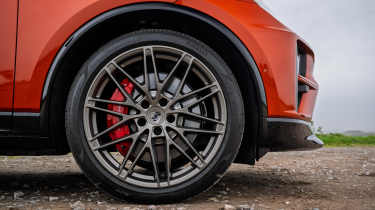Porsche Macan Electric – engine, gearbox and technical highlights
Up to 630bhp and Porsche’s new-gen EV platform, plus its latest (and mostly optional) chassis electronics
The Macan is built on a brand new PPE architecture, which has been developed alongside Audi to deliver significant gains in range, performance and dynamics. All models get a 95kWh (usable) lithium-ion battery pack positioned within the underbody, and like the Taycan, the Macan’s platform runs on an 800-volt system to benefit charging speeds (270kW, with a 10 to 80 per cent top up taking 21 minutes) and temperature management.
The Macan’s chassis systems are a bit of an acronym fest: it’s offered with ePTM (Porsche Traction Management), dual-valve PASM (Porsche Active Suspension Management) dampers and the Turbo gets PTV Plus (Porsche Torque Vectoring Plus). The latter adds an electronically-controlled locking differential on the rear axle and helps bring the chassis alive, as we’ll discuss later. Rear-wheel steering is offered as an option, too, while air springs and adaptive dampers are standard on the 4S and Turbo. To improve weight distribution, the latter’s rear motor is directly mounted to the body and positioned behind the back axle – 911 style.
Speaking of weight, the Macan carries a lot of it. In its lightest single-motor form it comes in at a chunky 2220kg, and the dual-motor Turbo crunches the scales at 2405kg. For a new EV running on a new-generation platform, that’s pretty poor.
The Macan does at least have the power to shift all that mass, generating up to 630bhp in Turbo form thanks to a pair of e-motors. And with precise control of torque output to the wheels, Porsche’s ePTM traction control system can respond faster and more accurately, responding to wheelspin in under 10 milliseconds. Power is transmitted via a single-speed gearbox, rather than the Taycan’s two-speed solution, and during normal everyday driving, up to 98 per cent of total braking energy can be recovered via regen.




